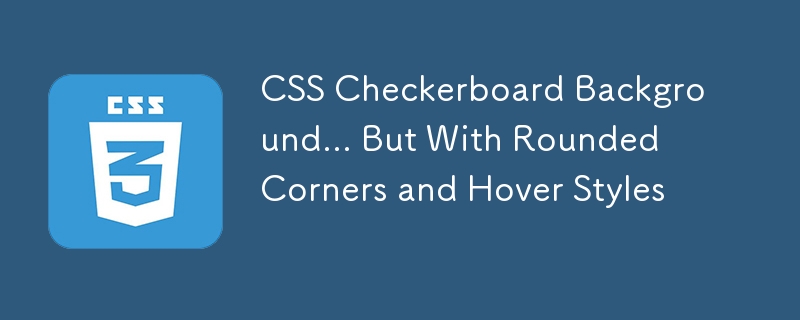 Web Front-end
Web Front-end
 CSS Tutorial
CSS Tutorial
 CSS Checkerboard Background... But With Rounded Corners and Hover Styles
CSS Checkerboard Background... But With Rounded Corners and Hover Styles
CSS Checkerboard Background... But With Rounded Corners and Hover Styles

Creating a simple checkered background with CSS is straightforward. However, achieving rounded corners without resorting to complex CSS gradients can be challenging. This article presents a creative solution using a clever trick with SVG glyphs.
Initially, I struggled to round the corners of a basic checkered pattern. Then, I remembered the versatility of the bullet point glyph (✦) and realized that overlaying it on each intersection could create the desired rounded effect.
Let's begin with the fundamental checkered pattern:
<div></div>
div {
background:
repeating-linear-gradient(
to right, transparent,
transparent 50px,
white 50px,
white 55px
),
repeating-linear-gradient(
to bottom, transparent,
transparent 50px,
white 50px,
white 55px
),
linear-gradient(45deg, pink, skyblue);
/* more styles */
}This code generates a repeating pattern of squares, transitioning from pink to skyblue, with 5px white gaps. The repeating-linear-gradient function creates horizontal and vertical white stripes, which, when layered, form the checkerboard. The third gradient provides the color fill.
To add the rounded corners, we overlay the bullet point glyph using an encoded SVG:
div {
background:
repeat left -17px top -22px/55px 55px
url("data:image/svg xml,<svg viewbox="0 0 35px 35px" xmlns="http://www.w3.org/2000/svg"><foreignobject height="35px" width="35px"><div style="color: white; font-size: 35px" xmlns="http://www.w3.org/1999/xhtml">✦</div></foreignobject></svg>"),
repeating-linear-gradient(
to right, transparent,
transparent 50px,
white 50px,
white 55px
),
repeating-linear-gradient(
to bottom, transparent,
transparent 50px,
white 50px,
white 55px
),
linear-gradient(45deg, pink, skyblue);
/* more style */
}The repeat keyword indicates a repeating background image. left -17px top -22px/55px 55px sets the position and size of each repeating unit, carefully offset to align with the grid intersections. The SVG contains an HTML <div> element displaying the glyph; its <code>font-size directly influences the square's corner radius. The expanded SVG looks like this:
<svg viewbox="0 0 35px 35px" xmlns="http://www.w3.org/2000/svg"><foreignobject height="35px" width="35px"><div style="color:white;font-size:35px" xmlns="http://www.w3.org/1999/xhtml">✦</div></foreignobject></svg>
Finally, let's add a hover effect:
div:hover {
background:
repeating-linear-gradient(
to right, transparent,
transparent 50px,
rgb(255 255 255 / 0.5) 50px,
rgb(255 255 255 / 0.5) 55px
),
repeating-linear-gradient(
to bottom, transparent,
transparent 50px,
rgb(255 255 255 / 0.5) 50px,
rgb(255 255 255 / 0.5) 55px
),
linear-gradient(45deg, pink, skyblue);
box-shadow: 10px 10px 20px pink;
}This removes the glyph on hover and makes the white lines semi-transparent using rgb() with alpha transparency. A box-shadow adds a subtle effect.
This technique provides a creative and effective way to achieve a rounded-corner checkerboard pattern with CSS, offering flexibility for various interactive styles. I welcome alternative approaches in the comments!
The above is the detailed content of CSS Checkerboard Background... But With Rounded Corners and Hover Styles. For more information, please follow other related articles on the PHP Chinese website!

Hot AI Tools

Undresser.AI Undress
AI-powered app for creating realistic nude photos

AI Clothes Remover
Online AI tool for removing clothes from photos.

Undress AI Tool
Undress images for free

Clothoff.io
AI clothes remover

Video Face Swap
Swap faces in any video effortlessly with our completely free AI face swap tool!

Hot Article

Hot Tools

Notepad++7.3.1
Easy-to-use and free code editor

SublimeText3 Chinese version
Chinese version, very easy to use

Zend Studio 13.0.1
Powerful PHP integrated development environment

Dreamweaver CS6
Visual web development tools

SublimeText3 Mac version
God-level code editing software (SublimeText3)

Hot Topics
 1677
1677
 14
14
 1431
1431
 52
52
 1334
1334
 25
25
 1279
1279
 29
29
 1257
1257
 24
24
 A Comparison of Static Form Providers
Apr 16, 2025 am 11:20 AM
A Comparison of Static Form Providers
Apr 16, 2025 am 11:20 AM
Let’s attempt to coin a term here: "Static Form Provider." You bring your HTML
 Weekly Platform News: HTML Loading Attribute, the Main ARIA Specifications, and Moving from iFrame to Shadow DOM
Apr 17, 2025 am 10:55 AM
Weekly Platform News: HTML Loading Attribute, the Main ARIA Specifications, and Moving from iFrame to Shadow DOM
Apr 17, 2025 am 10:55 AM
In this week's roundup of platform news, Chrome introduces a new attribute for loading, accessibility specifications for web developers, and the BBC moves
 A Proof of Concept for Making Sass Faster
Apr 16, 2025 am 10:38 AM
A Proof of Concept for Making Sass Faster
Apr 16, 2025 am 10:38 AM
At the start of a new project, Sass compilation happens in the blink of an eye. This feels great, especially when it’s paired with Browsersync, which reloads
 Some Hands-On with the HTML Dialog Element
Apr 16, 2025 am 11:33 AM
Some Hands-On with the HTML Dialog Element
Apr 16, 2025 am 11:33 AM
This is me looking at the HTML element for the first time. I've been aware of it for a while, but haven't taken it for a spin yet. It has some pretty cool and
 Paperform
Apr 16, 2025 am 11:24 AM
Paperform
Apr 16, 2025 am 11:24 AM
Buy or build is a classic debate in technology. Building things yourself might feel less expensive because there is no line item on your credit card bill, but
 Quick Gulp Cache Busting
Apr 18, 2025 am 11:23 AM
Quick Gulp Cache Busting
Apr 18, 2025 am 11:23 AM
You should for sure be setting far-out cache headers on your assets like CSS and JavaScript (and images and fonts and whatever else). That tells the browser
 Where should 'Subscribe to Podcast' link to?
Apr 16, 2025 pm 12:04 PM
Where should 'Subscribe to Podcast' link to?
Apr 16, 2025 pm 12:04 PM
For a while, iTunes was the big dog in podcasting, so if you linked "Subscribe to Podcast" to like:
 Weekly Platform News: Text Spacing Bookmarklet, Top-Level Await, New AMP Loading Indicator
Apr 17, 2025 am 11:26 AM
Weekly Platform News: Text Spacing Bookmarklet, Top-Level Await, New AMP Loading Indicator
Apr 17, 2025 am 11:26 AM
In this week's roundup, a handy bookmarklet for inspecting typography, using await to tinker with how JavaScript modules import one another, plus Facebook's



